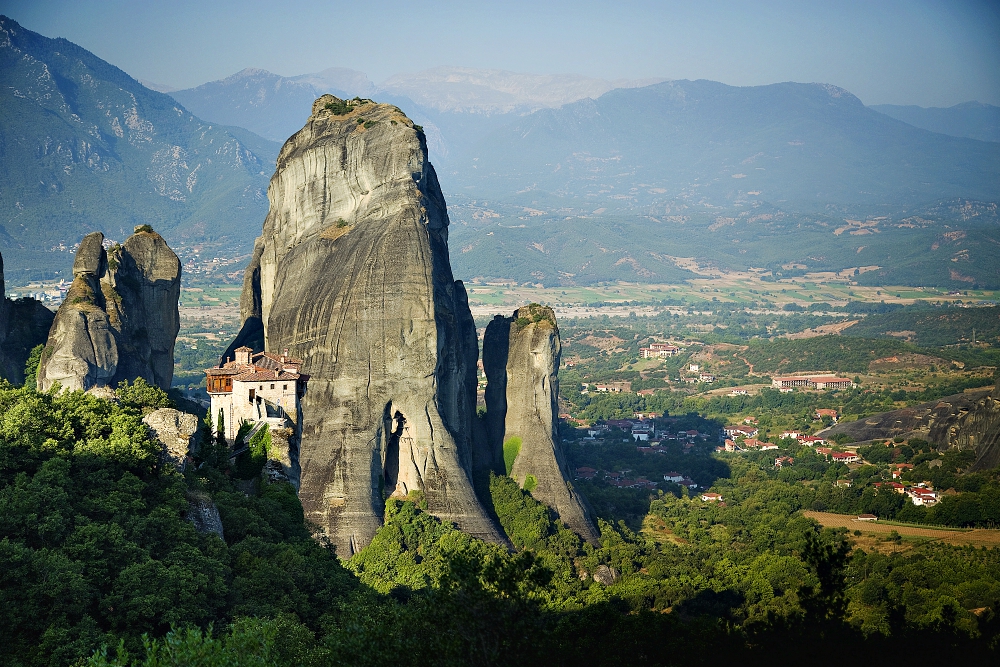
St. Barbara of Roussanou Monastery perches at the edge of a towering hilltop in Meteora, Greece. (Wikimedia Commons/Dennis D. Auger)
St. Barbara of Roussanou's Greek Orthodox monastery perches at the edge of a towering hilltop in Meteora, Greece. As one of Meteora's six active monasteries, its medieval stone walls drop off at either side of a cliff. Hiking a footpath to St. Barbara's, I can see the abandoned ruins of other monasteries scattered on peaks across the landscape. When I finally ascend to the chapel entrance, I pray that St. Barbara's stone walls will prove more stable!
As a participant on FutureChurch's "Foremothers in Faith" pilgrimage, I visited Meteora while retracing the footsteps of ancient women who influenced the development of early Christianity. FutureChurch co-founder St. Joseph Sr. Christine Schenk; our Greek tour guide, Aliki; and FutureChurch board of trustees chair Jocelyn Collen were incredible leaders on the weeklong journey.
With their guidance, our group navigated the cliffs of Meteora and we immersed ourselves in a week packed with fascinating historical sites, inspiring stories, prayer and education. Each step led us further back into a narrative that is deeply embedded, and yet largely remains unspoken in our Christian faith.
This narrative is rooted in the lives of early Christian women, whose influence we explored at numerous ancient sites. Near Philippi, we remembered Lydia of Thyatira, who met Paul at a riverside woman's worship service and eventually led the city's house church. Here, Euodia and Syntyche also ministered as "co-workers" of Paul (Philippians 4:2-3).
At Thessaloniki, we honored fourth-century women martyrs led by Agape, Eirene and Chione. In Corinth, we learned about Priscilla and Aquila, a missionary couple who also worked as tentmakers. Paul met this duo in Corinth, whose ruins still display a stoa similar to that which housed Corinth's first Christian community.
And of course, we journeyed to Cenchreae to honor Phoebe, the woman who Paul calls diakonos and who delivers his letter to the Romans (Romans 16:1-2).
Advertisement
Such rich Christian history also overlapped with that of the ancient Greeks and Romans. Trekking up the mountainside ruins of Delphi, for example, we learned about worshipers of the earth goddess Gaia who honored an exquisitely beautiful valley as the bellybutton of the world. On the island of Aegina, we gathered near the temple of the fertility goddess Aphaea to reflect on our own expressions of life and creativity in the world.
While I have studied the history of many early Christian women, personally visiting these sites feels entirely different. Each place holds enough stories to fill hundreds of columns — certainly more than I could ever remember. The trip was transformative in a way that I cannot yet fully describe — it offered tremendous learning and also raised pressing questions.
How, for instance, can we more fully recount and celebrate the lives of these women in our faith community?
What wisdom do they hold for our understanding of women's contributions in the contemporary church?
In what ways can we integrate this wisdom into our faith life, and especially work to ensure that our young people can also tap into the memory of these early foremothers?
As a faith community, we urgently need to explore these questions. In the process, the story of Phoebe's voyage from Cenchreae can offer inspiration for our journey.

The ruins of an early Christian basilica and the Temple of Isis in the harbor of Cenchreae in Greece (Wikimedia Commons/Carole Raddato)
Today, the ruins of her ancient town remain largely neglected along a country roadside. Silted layers of earth cover much of the archeological site, while the remainder is mostly submerged beneath the waters of a shifting coastline. Along the beach, pebbles mix with shattered bits of ancient pottery whose jagged edges have been smoothed over by centuries of waves.
Looking across the water, it feels daunting to imagine Phoebe setting off across these waves for Rome. I admire the faith, passion and single-minded audacity she needed to embark on this journey (especially with no GPS at the time!).
Today, Phoebe's witness inspires a different kind of journey for our church. This trek is one that seeks to reclaim the stories of our foremothers in faith. Like those at Cenchreae, these stories have been submerged beneath the waters of history. Whether we are led into Phoebe's town or up a towering Meteora cliff, this journey will almost certainly take us into spaces "at the edge" — edgy not only for their physical location, but also for the creative spirit of the women who inhabited them.
This journey not only draws us back, but also urges us forward. Leaning into the future, it calls people of faith to imagine — as Phoebe and these early women surely did — the kind of church we can yet create.
[Jennifer Mertens teaches religion at a Catholic high school in Cincinnati. She holds a Master's of Divinity degree from the Catholic Theological Union.]
Editor's note: We can send you a newsletter every time a Young Voices column is posted to NCRonline.org. Go to this page and follow directions: Newsletter sign-up.





